The section describes the upgrade of clustered systems.
The operational environment must be prepared prior to upgrading the AdvancedCopy Manager's agent, as described below.
Check that Managed Server transactions are stopped on the secondary node.
If not stopped, use the Failover Cluster Manager to stop Managed Server transactions on the secondary node.
If multiple Managed Server transactions exist, perform this procedure on each secondary node for Managed Server transactions.
Stop the Managed Server transaction on the primary node.
Use the Failover Cluster Manager to stop the Managed Server transactions.
However, the shared disk for shared data of Managed Server transactions must be online.
If multiple Managed Server transactions exist, perform this procedure on each primary node for Managed Server transaction.
Stop the local transactions on all the nodes, perform the following procedure:
Select Control Panel > Administrative Tools > Services.
Select "AdvancedCopy Manager COM Service" and then click Stop.
Back up the environment and data.
Back up the Windows system on the primary and secondary nodes.
Back up the shared disk for shared data of Managed Server transactions on the primary node.
If multiple Managed Server transactions exist, back up the shared disk for shared data of Managed Server transactions on each the primary node for Managed Server transactions.
Point
If a failure occurs during the upgrade, you cannot restore the environment to the pre-installation status (rollback). Therefore, back up the following before the upgrade.
Windows system
Shared disk for shared data of Managed Server transactions
If a failure occurs during the upgrade, restore the system from the backup.
Note
When the Storage Cruiser's agent has been installed, it is necessary to perform the Upgrade Installation according to the following procedures. Refer to "Starting and Stopping the Agent" in "Command reference" in the ETERNUS SF Storage Cruiser Operation Guide for the how to stop of the service of the Storage Cruiser's agent.
Stop the service of Storage Cruiser's agent.
Stop the service of AdvancedCopy Manager's agent.
Upgrade the AdvancedCopy Manager's agent.
Start the service of Storage Cruiser's agent.
The following describes the upgrade procedure for the primary node.
If multiple Managed Server transactions exist, use this procedure on each primary node for Managed Server transactions.
Log on to the server using Administrator privileges.
Check the architecture of the installed AdvancedCopy Manager's agent.
Select Control Panel > Add or Remove Programs to check the architecture of AdvancedCopy Manager's agent.
For "AdvancedCopy Manager (x86) - Agent":
32-bit AdvancedCopy Manager's agent is installed.
For "AdvancedCopy Manager (x64) - Agent":
64-bit AdvancedCopy Manager's agent is installed.
Insert the DVD-ROM "ETERNUS SF SC/ACM/Express Mediapack for Windows (Agent Program and Manual)" for this version into the DVD-ROM drive.
Refer to "DVD-ROM contents" in the ETERNUS SF Installation and Setup Guide for this version for information on the DVD-ROM structure and detailed contents.
The following window will be displayed.
For the upgrade installation, this window is not used. Click Exit.
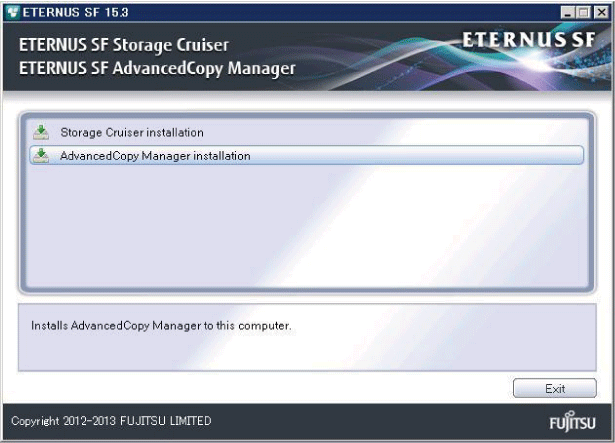
Start the following installation wizard corresponding to the architecture of AdvancedCopy Manager's agent checked in step 2.
For 32-bit version:
dvdromDrive:\Agent_windows\AdvancedCopy_Manager\agent\windows_x86\setup.exeFor 64-bit version:
dvdromDrive:\Agent_windows\AdvancedCopy_Manager\agent\windows_x64\setup.exeThe following dialog box will be displayed. Click Yes.
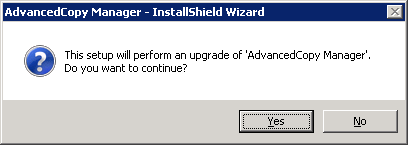
The following installation wizard page will be displayed. Click Next.
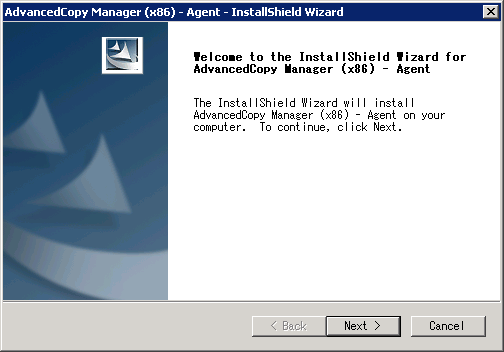
Read the terms and conditions of the License Agreement page.
If the conditions are agreeable, click Yes.
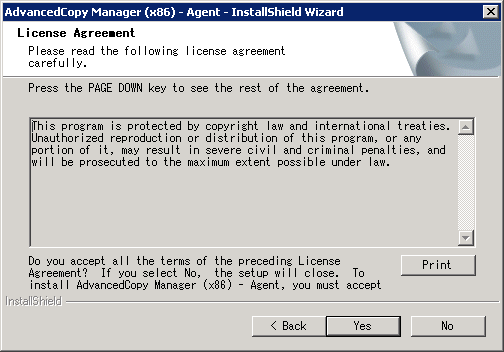
Check the settings information in the Start Copying Files page. If the settings are correct, click Next. To change a setting, click Back.

Copying of the program is started.
The following installation wizard page will be displayed. The upgrade process is completed. Click Finish.
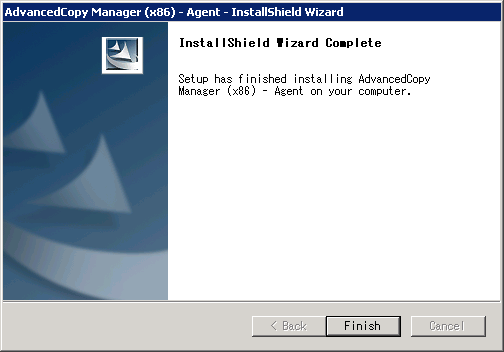
Eject the DVD-ROM.
When the upgrade has been completed, the tasks below need to be performed:
If multiple Managed Server transactions exist, use this procedure in each primary node for Managed Server transaction.
Edit the following environment setting files for Managed Server transaction on the shared disk for shared data:
<Drive of shared disk for shared data of Managed Server transaction>:\etc\opt\swstorage\clsetup.ini
<Drive of shared disk for shared data of Managed Server transaction>:\etc\opt\swstorage\etc\swstg.ini
Change the version information within each file, as follows:
Upgrade patterns | Descriptive contents of the version information | |
|---|---|---|
Before | After | |
Version 15.0B to 15.3 | Version=V15.0 | Version=V15.3 |
Version 15.1 to 15.3 | Version=V15.1 | |
Version 15.2 to 15.3 | Version=V15.2 | |
Note
Do not change anything other than the version information.
Perform the upgrade for the secondary node.
The upgrade procedure is the same as that for the primary node. Refer to "7.3.2.2 Performing the upgrade (Primary node)".
Point
If this secondary node acts as a primary node for other Managed Server transactions, it is upgraded as a primary node, so this procedure is not needed.
There is no further action required after the upgrade for the secondary node.
After the upgrade, perform the following procedure:
Start the Managed Server transactions on the primary node.
Use the Failover Cluster Manager to start the Managed Server transactions.
If multiple Managed Server transactions exist, perform this procedure for each Managed Server transaction.
Start the local transactions on all the nodes, perform the following procedure:
Select Control Panel > Administrative Tools > Services.
Select "AdvancedCopy Manager COM Service" and then click Start.
Change the server information for Managed Server transactions.
To ensure data consistency, execute the stgxfwcmmodsrv command to change the server information.
When executing the stgxfwcmmodsrv command, specify the Managed Server name for the -n option.
This command should be performed on the Management Server.
If multiple Managed Server transactions exist, perform this procedure for each Managed Server transaction.
In addition, if there is any node that is running local transactions, perform this procedure on the relevant node.
Note
For changing the server information, start a new window for command execution, and then perform the procedure on the window.
See
Refer to "stgxfwcmmodsrv (Server information change command)" in the ETERNUS SF AdvancedCopy Manager Operation Guide relevant to the OS of the Management Server for information on the command.
Reload the server information using the Web Console.
See
Refer to "Reload the server configuration information" in the ETERNUS SF Web Console Guide for this version for information on reloading server information.